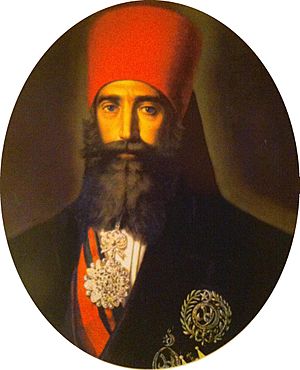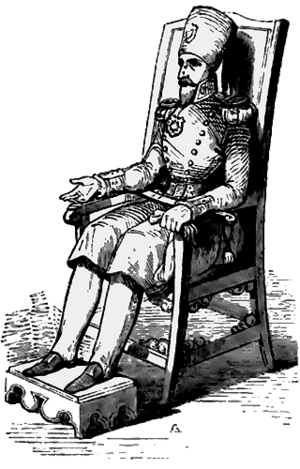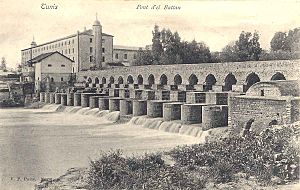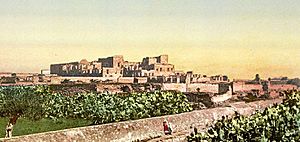Ahmad I ibn Mustafa facts for kids
Quick facts for kids Ahmad I ibn Mustafa |
|
|---|---|
 |
|
| Bey of Tunis | |
| Reign | 10 October 1837 – 30 May 1855 |
| Predecessor | Mustafa ibn Mahmud |
| Successor | Muhammad II ibn al-Husayn |
| Born | 2 December 1805 |
| Died | 30 May 1855 (aged 49) |
| Dynasty | Husainides |
| Religion | Islam |
Ahmad I (Arabic: أبو العباس أحمد باشا باي) was the tenth Bey of Tunis. He was born on December 2, 1805, in Tunis. He ruled from 1837 until his death on May 30, 1855, at La Goulette.
Ahmad I is most famous for ending slavery in Tunisia in 1846. He took over from his father, Mustafa Bey, on October 10, 1837. Ahmad Bey had big plans for Tunisia. He wanted to make his army stronger and build a modern navy. He also dreamed of new royal buildings and better schools. However, these projects were very expensive. They ended up costing a lot of money and hurt the country's finances.
Contents
Becoming Bey: Ottoman Approval

Soon after Ahmad Bey became ruler, he received a special letter. This letter was called a Firman. It came from the Ottoman Empire, which was a powerful empire at the time. The Firman officially gave him the power to rule Tunis. It also came with special gifts and symbols of his new job.
An Ottoman messenger, Osman Bey, arrived in La Goulette in May 1838. He rode into Tunis with a grand parade. All the Bey's ministers rode ahead of him. The messenger carried a special sword and robe for Ahmad Bey. A few days later, the messenger officially gave Ahmad Bey these items at the Bardo Palace.
Ahmad Bey was given a high rank in the Ottoman army. He became a Divisional General in 1838. Later, the Sultan promoted him to Marshal in 1840. This was a very important step. No Bey of Tunis had ever held such a high rank before. These honors showed that the Ottoman Empire was still in charge of Tunisia.
Building Ties with France
Tunisia had a treaty with France from 1830. This treaty allowed France to build a monument in Carthage. It was for Louis IX of France, a French king who died there long ago. In 1840, the first stone was laid for a church in Carthage. Ahmad Bey also let the Christian people in Tunis make their church bigger. Most of these Christians were European traders.
In 1846, the Duke of Montpensier visited Tunis and Carthage. He was the son of the French King Louis Philippe I. Ahmad Bey welcomed him with great respect. During this visit, the idea came up for Ahmad Bey to visit France.
Ahmad Bey visited France in November 1846. King Louis Philippe welcomed him with a grand ceremony. This visit made Ahmad Bey even more determined to modernize Tunisia. He wanted to learn from Europe's progress. An old article from 1897 said that he was very impressed by new machines and factories. He wanted to bring modern industries to Tunisia.
The Ottoman Empire was not happy about this visit. They saw Ahmad Bey as their ruler, not an independent king. The special welcome he received in France made them think he was acting too independently.
Modernizing Tunisia
Ahmad Bey wanted to make his country more modern. He focused on how the government worked, the army, and education. He created a new government structure. His top officials were called 'ministers'.
His main ministers included:
- Mustafa Sahib at-Taba'a, his Grand Vizier (like a prime minister)
- Mustapha Khaznadar, in charge of money and internal affairs
- Mustafa Agha, Minister of War
- Mahmoud Khodja, Minister of the Navy
- Giuseppe Raffo, Foreign Minister
One of Ahmad Bey's greatest achievements was ending slavery in January 1846. He also started a military academy in Bardo in 1840. This academy helped train his army. The army grew to about 5,000 soldiers. They had infantry, artillery, and cavalry units.
Ahmad Bey also improved religious education. He brought in many professors for the Al-Zaytuna Mosque. He paid them himself. He also gave many old Arabic books to the mosque.
He also encouraged new businesses. He asked Mahmoud Ben Ayed to build factories for the army. In 1840, a textile factory was built in Tebourba. It used water power and later steam engines from Britain. Other factories were built too, like tanneries and a cannon factory.
New government offices were created to help manage things. These offices handled grain storage, olive oil forests, and government purchases. A mint was also opened at Bardo to make coins.
However, not all his ideas worked out. For example, he had a huge warship built at La Goulette. But it was so big that it couldn't fit through the channel to reach the sea!
Challenges in Reforms
Ahmad Bey's modern ideas didn't change the daily lives of most people much. They also didn't greatly improve the economy. He wasn't very interested in improving the city of Tunis itself. He did rebuild a mosque and restore a gate.
He spent a lot of money on royal palaces. He built a very expensive palace called Salehia in Mohamedia. But he rarely used it. Ahmad Bey wanted to make big changes, especially in money and the army. But his government didn't fully understand how much these changes would cost. They also lacked the right experts to carry them out. This meant many of his plans didn't succeed as he hoped.
His Family
Unlike many rulers of his time, Ahmad Bey had only one wife and one concubine. Before slavery was ended, he would often give away female slaves he received as gifts to his officials. He had two children, but they both died when they were very young. Because he had no children who lived, his cousin, Muhammad Bey, became the next ruler after him.
Ahmad Bey died in 1855 at his summer palace in La Goulette. He was buried in the Tourbet el Bey in the old city of Medina of Tunis.
See Also
- Tunisian navy under Ahmed Bey




